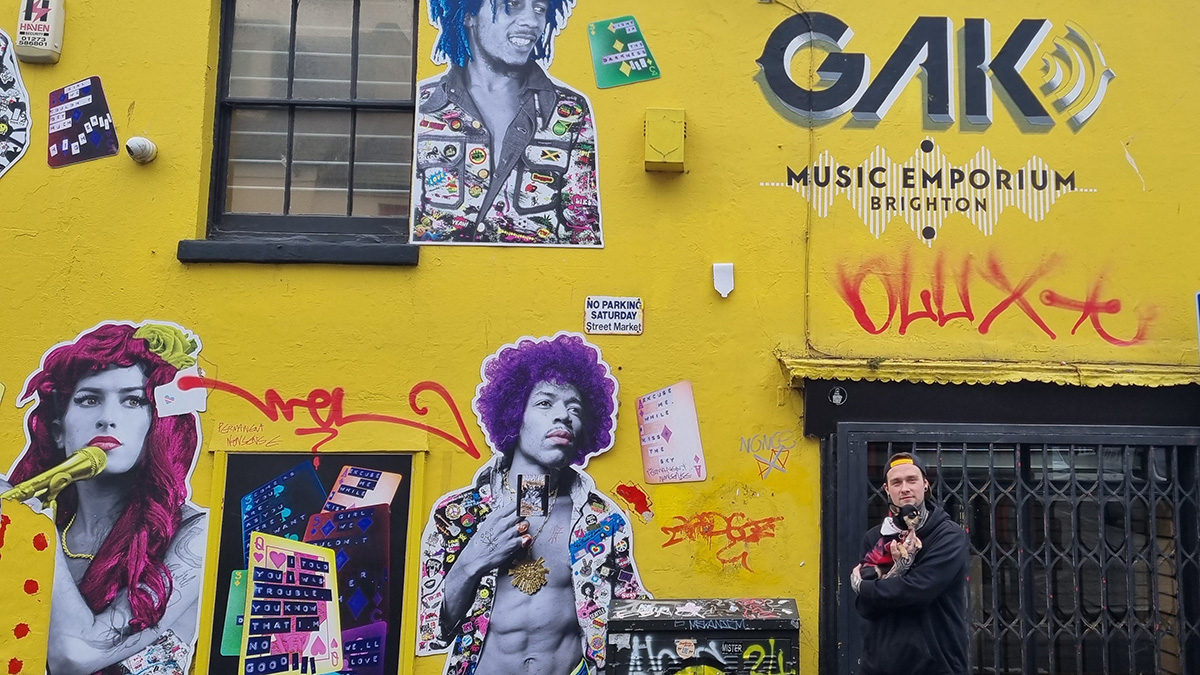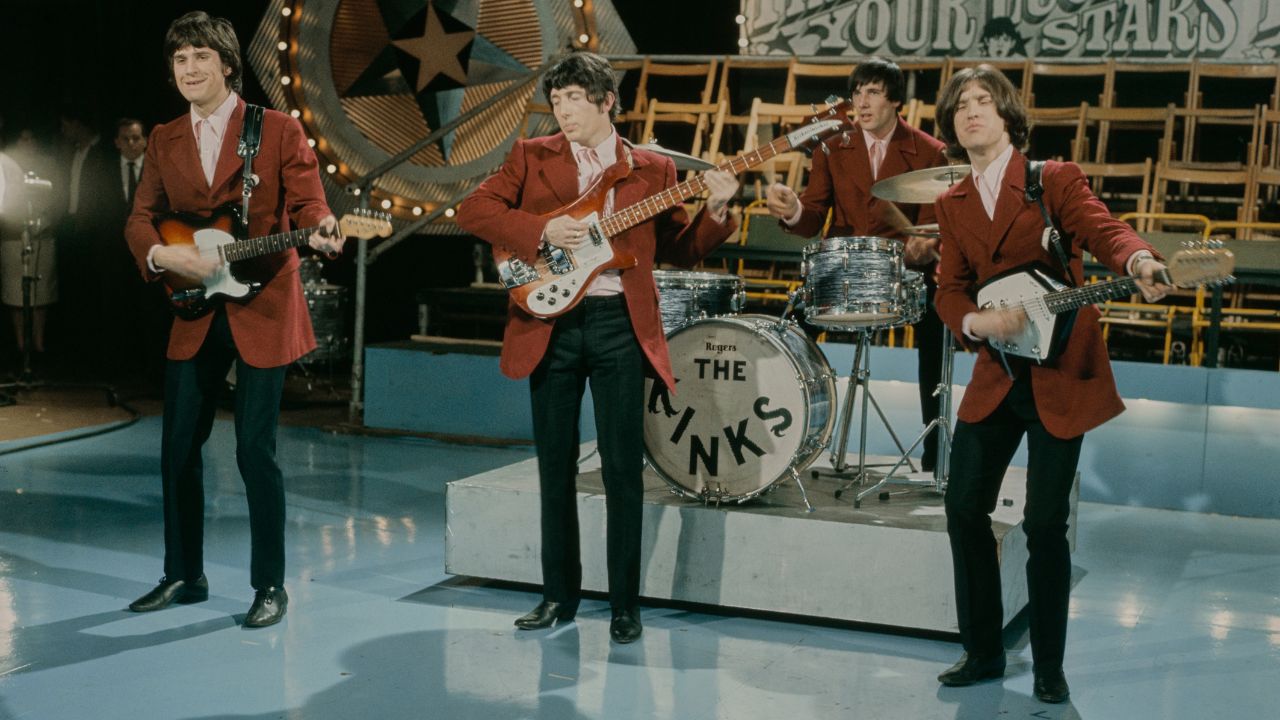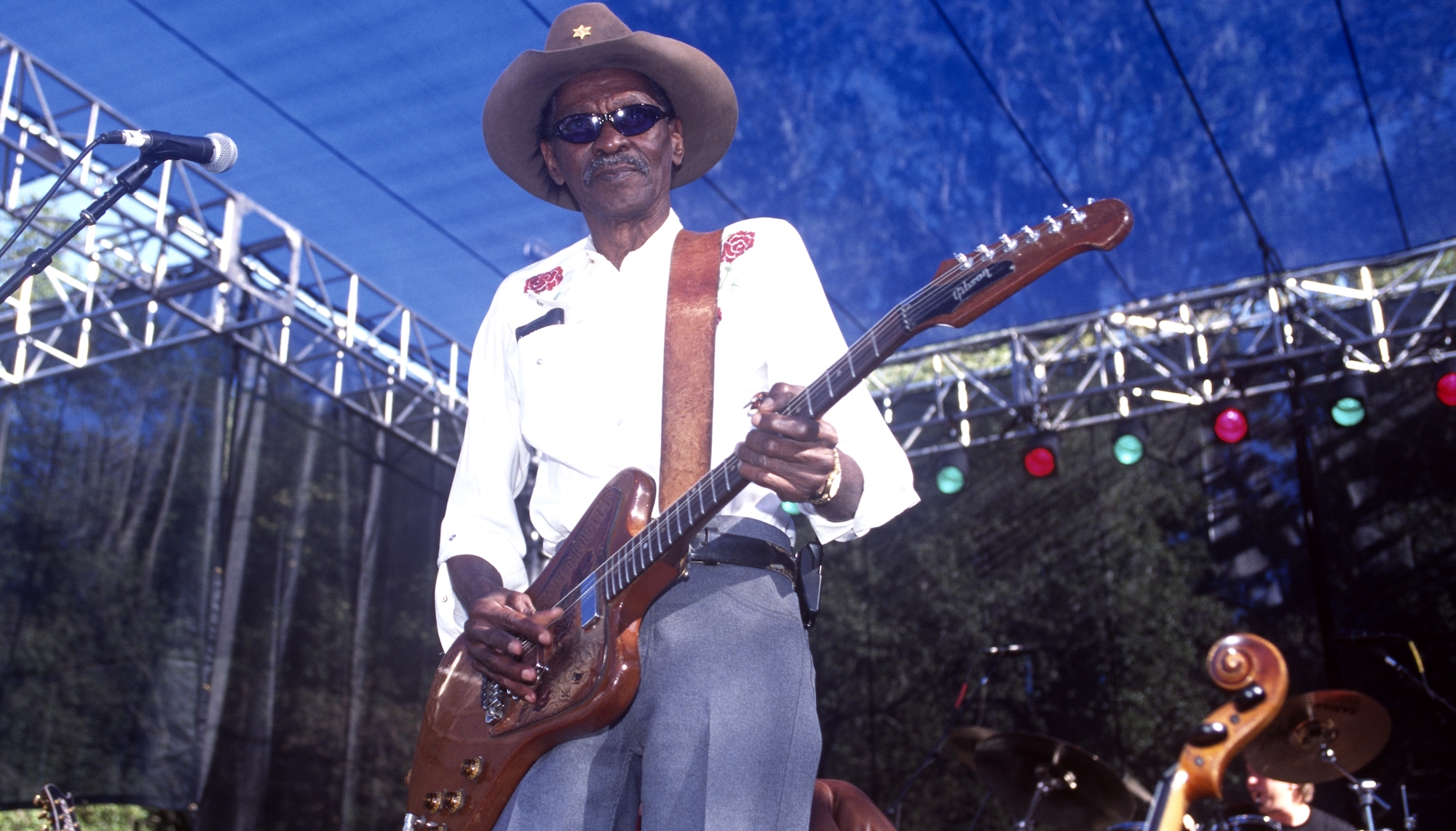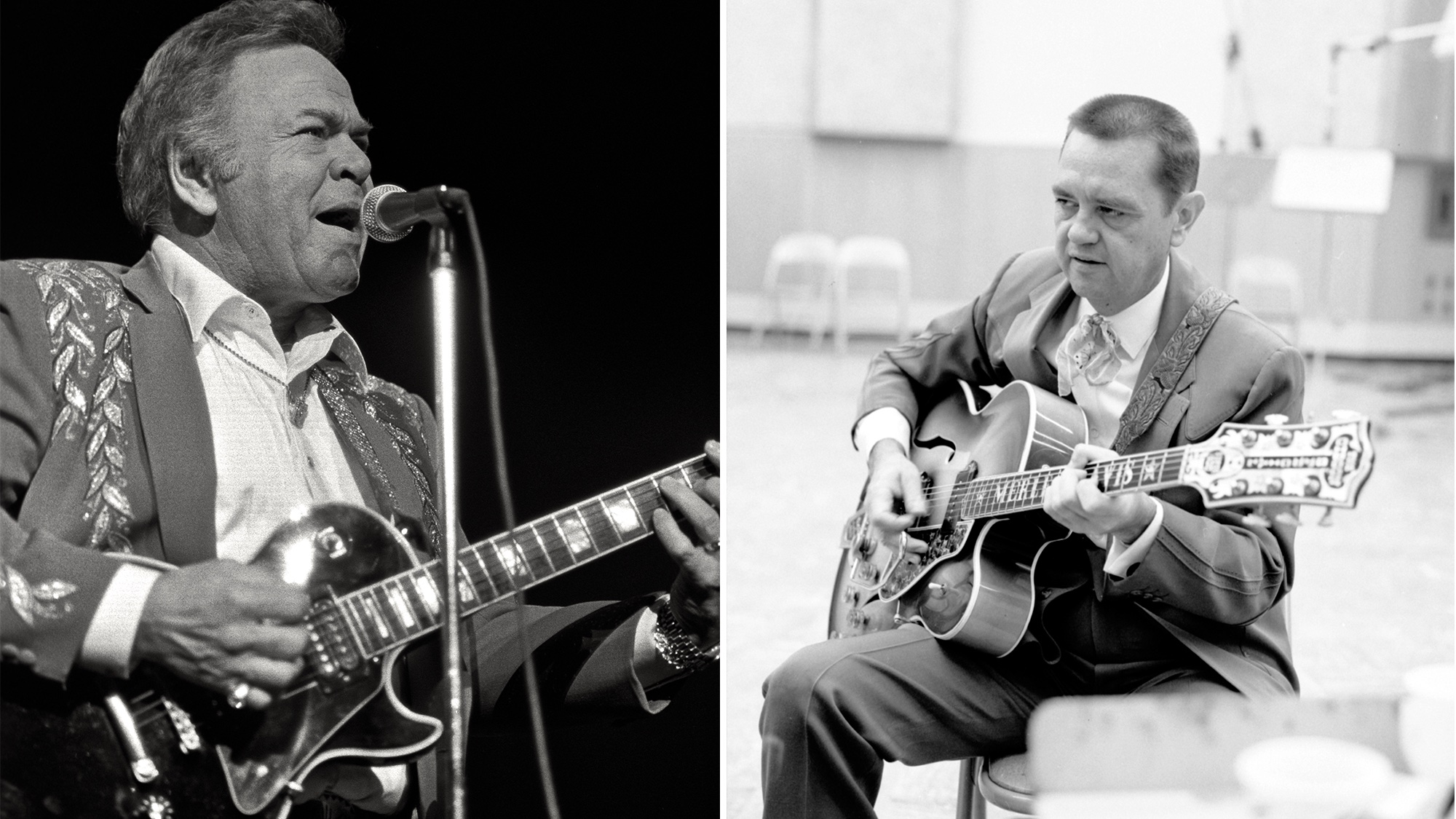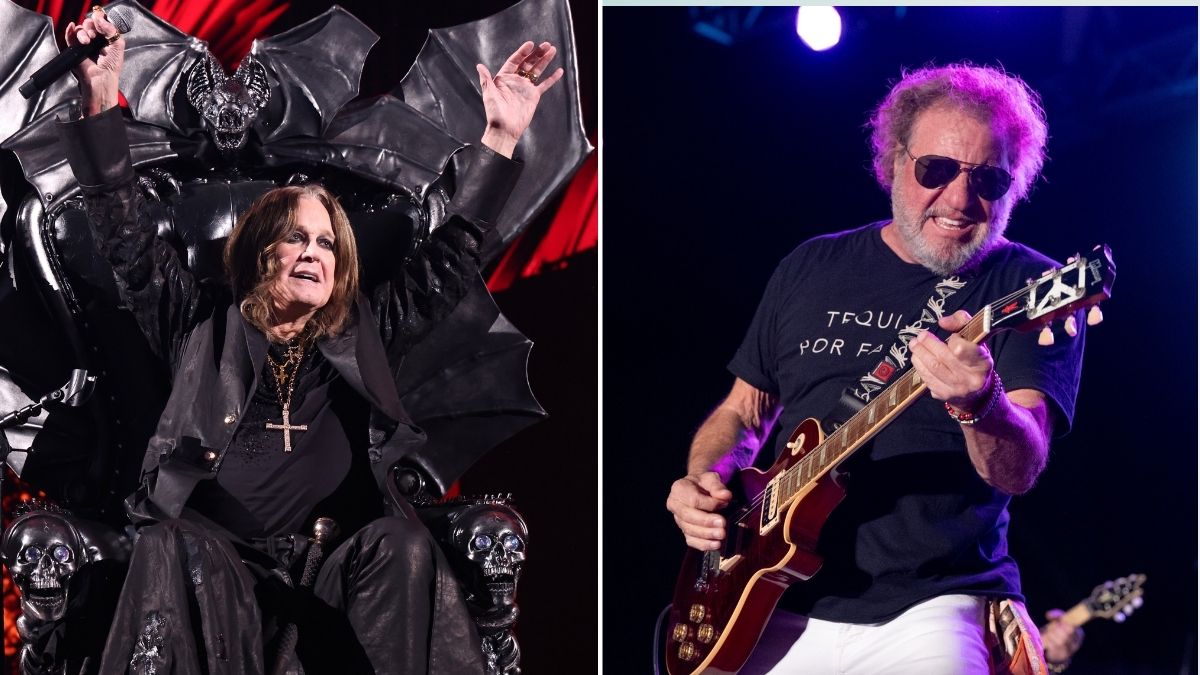What happened to Jimi Hendrix’s Stratocasters? Tracking down the guitars that made music history
Sold on to collectors or lovingly sacrificed to the music gods, Hendrix’s Strats are the stuff of Arthurian legend
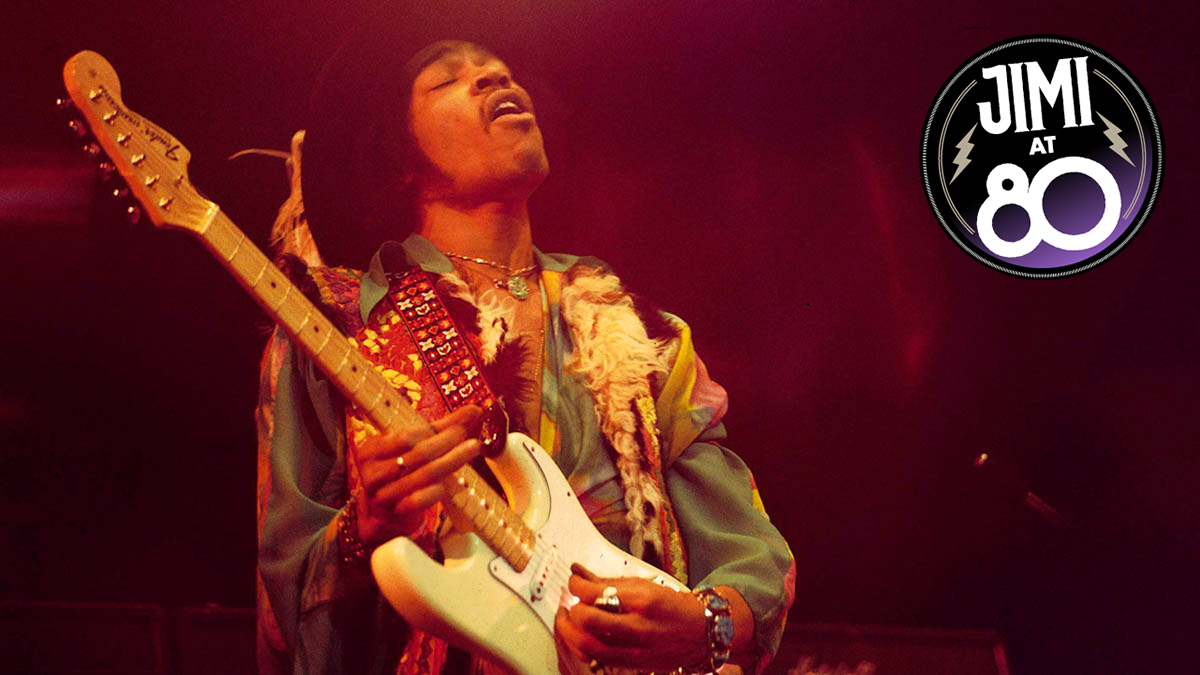
Jimi Hendrix arrived in London from New York City in September 1966 with his new manager, Chas Chandler, the ex-bass player from The Animals. They soon put together Jimi’s new band, the Experience, with Mitch Mitchell on drums and Noel Redding on bass, and by the middle of October that year they were playing their first proper gigs on a brief tour supporting Johnny Hallyday in France.
It’s not clear if Jimi brought with him to London the guitar he was playing during those early months. It was an Olympic White finish Fender Stratocaster with a maple neck and rosewood fingerboard, made most likely between ’63 and ’65. Perhaps he bought it in London? It was unlikely that he or Chas had the cash to buy a new one – a brand new custom-colour Strat similar to this white one listed at £168 at the time. That’s a lot of money for a musician still to prove himself. If he bought it secondhand in one of London’s music shops in late ’66, he’d have needed a more manageable sum, between about £60 and £90. The Selmer shop in Charing Cross Road, for example, advertised “Strats, all finishes, from £75” at the time.
Wherever it came from, Jimi’s first white Strat served him well for a while, alongside a secondhand black one with rosewood ’board that he got around November. By February of the following year, things were looking up. The Experience had played the Marquee and the Saville Theatre in London and a number of other gigs in Britain, plus a few in Germany and France. Work on recording a follow-up single to Hey Joe had begun – and Purple Haze would go to No 3 in the UK. Reports suggest that, during February, Jimi had a black Strat stolen from a gig in Darlington and a white Strat from London’s Roundhouse. He soon acquired at least one more white one and at least one sunburst model, all with rosewood ’boards.
Jimi made more players aware of the Strat’s tonal and musical possibilities than any musician before him
Jimi was, of course, left-handed, and all his Strats were regular guitars that he would flip over and restring to accommodate that. It’s a matter of debate how much difference this made to his sound – the reversed nut, the angled bridge pickup accentuating different strings than intended, the vibrato handled differently – but with the high volume levels at which he played, and his natural dexterity and playing skill, any differences were probably minimal. Less open to debate is that Jimi made more players aware of the Strat’s tonal and musical possibilities than any musician before him.
At first, he would tune his Strats to regular concert pitch, but soon he favoured tuning them down a half step and sometimes a whole step. It meant less strain on his voice because he could sing in a slightly lower register, and also the newly lower-pitched strings were slightly slacker and therefore easier to bend. He liked the neck pickup’s full tone, and occasionally he’d use the different tones from the two in-between positions of the three-way selector.
At the end of March ’67, Jimi started a British tour on a bill with what we might call a varied line-up, alongside The Walker Brothers, Cat Stevens and Engelbert Humperdinck.
The opening night in north London at the Finsbury Park Astoria (better known later as the Rainbow) saw the music press in attendance, and Jimi, Chas, road manager Gerry Stickells, and Keith Altham from the New Musical Express got together in the dressing room to come up with a stunt to get some coverage. Keith suggested, as something of a joke, that Jimi might burn a guitar. Chas smiled and sent Gerry out for some lighter fluid.
Get The Pick Newsletter
All the latest guitar news, interviews, lessons, reviews, deals and more, direct to your inbox!
“The guitar went up about halfway through Wild Thing,” Keith recalled later in Q magazine, “with Jimi straddling his Fender and applying several matches before the instrument caught alight. There was a pathetic little pile of used matches on the stage afterwards. It was not exactly a towering inferno, but Jimi made the most of it by whirling the guitar around his head and throwing in a touch of the mad axeman for good measure.”
Unsurprisingly, the fire officer at the theatre was unimpressed, but Jimi still got his headlines. Chris Welch’s story on the blazing event was on the front page of the following week’s Melody Maker.
“Jimi sustained a burned hand when his guitar accidentally burst into flames at the climax of his act,” Chris wrote. “Hendrix was lying on stage playing the guitar with his teeth when it suddenly burst into flames. Jimi leapt backwards and ran off stage followed by his group.
“The guitar was left burning dangerously near the closed curtains, and compere Nick Jones ran and tried to pick it up, burning his hand in the attempt. An attendant rushed on stage with a fire extinguisher and put out the flames, which were leaping 10ft in the air.”
Strat Calculation
It took more than a fiery story in Melody Maker, but soon Jimi was making real ground. His first album, Are You Experienced, was released in Britain in May 1967 and streaked up the LP charts to No 2.
He was playing more gigs than ever, and his wild onstage performances meant the Strats he used took a real beating – as did Jimi’s teeth from his regular dental‑picking routine.
By May ’67, he was playing at least one sunburst Strat with rosewood ’board, and for a Top Of The Pops TV performance of Purple Haze he mimed with what looked like a Fiesta Red finish Strat. Chas talked to Ray Jones at Beat Instrumental around this time and said that Jimi had already been through six Strats: two stolen (presumably the Aldershot black one and the Roundhouse white one), two others “fogged up on him” (surely a southerner’s misquote of Chas’s north-eastern accent), and two that Jimi “always carries on gigs”.
Usually, Jimi reserved one of the two gigging guitars for his more extreme stage antics. Richard Green wrote in Record Mirror: “He kisses the guitar, sits on it and treads on it. Quite apart from belting it with his elbow and caressing the amplifier with it.”
The sequence where Jimi “caressed” the speaker cabinets with his Strat seemed to another observer more like aggressively “humping the amp”. It did no favours to the poor instrument earmarked for such treatment, nor to those charged with keeping the guitars roadworthy.
The team would vary from time to time, but most often in mid-’67 there was Gerry Stickells (road manager) and Neville Chesters (roadie), and sometimes Roger Mayer (technical support). They were exploiting the Strat’s screw-together construction and would strip and swap bodies, necks, pickguards, controls and more. This makes it especially difficult to determine, in hindsight, how many Strats Jimi used.
We’ll almost certainly never know for sure, but there were probably no more than 15 base instruments – regularly repurposed and chopped about, sometimes with the same neck appearing on several bodies – right up to the point in 1968 when, as we’ll see, Jimi appeared to settle on two primary instruments.
Smashed at the Saville
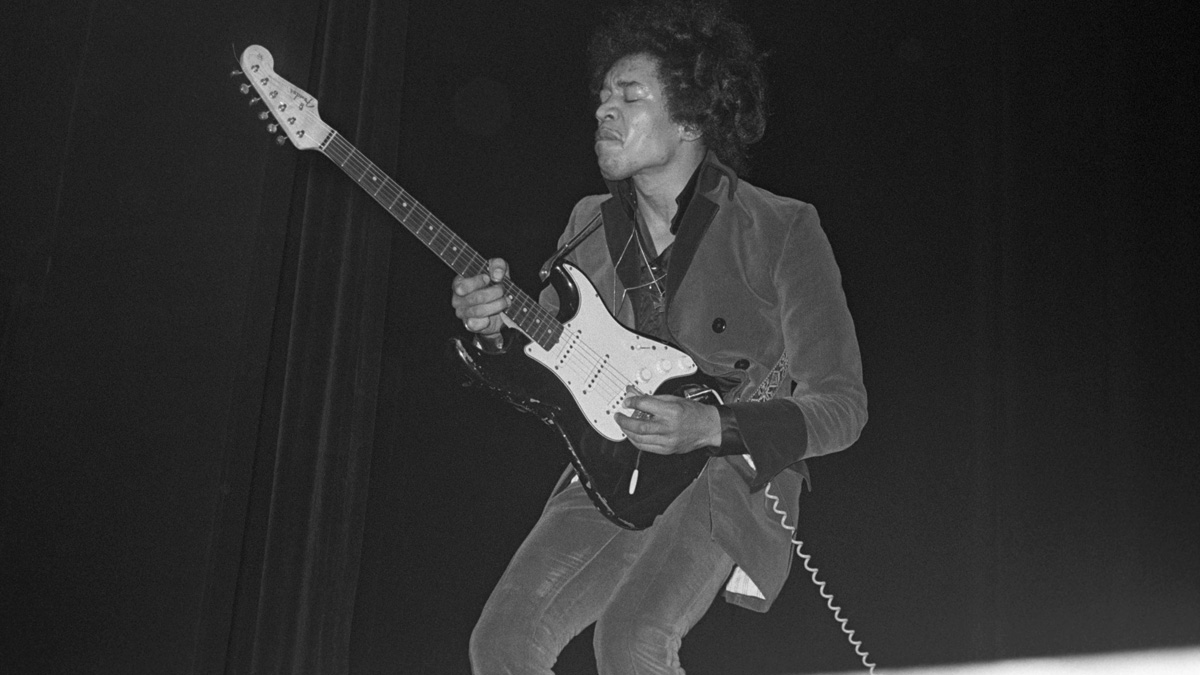
Roger Mayer recalls the changing nature of the Strats reserved for the rough treatment. “We called them the sacrificial guitar,” he says with a smile. “It would be put together from all the scraps we had, just to make a guitar that worked for the end of the show, when Jimi was jumping on it and everything.
“Obviously, that wasn’t one of the better ones. Maybe it would only have one working pickup, which we would wire directly – and there’d be no point for the volume control to work, because why would Jimi want to play on anything less than 10?”
One victim of the onstage frenzy was a Candy Apple Red model, with a rare sighting at this period for Jimi of a maple ’board. He used it through a European stint in May ’67 when it was fitted with a procession of non-standard knobs and switch tips thanks to the hammering it took against the speakers and elsewhere.
Chas told New Musical Express later: “The smashing routine really began by accident. Jimi was pulled off stage by a few over-enthusiastic fans, and as he jumped back on the stage he threw his guitar on before him. When he picked it up he saw that it had cracked and several of the strings were broken – he just went barmy and smashed everything in sight. The German audience loved it, and we decided to keep it in as part of the act.”

By the end of May the guitar was in a sorry state, the crack developing from the bridge right back across the rear of the body. Jimi decided it was time for this one to go, but rather than consign it to the parts bin, he chose to give it a special send-off. Another show at the Saville Theatre loomed in early June, the last British gig before the Experience went off for Jimi’s homecoming US tour that would last until August of that year.
He planned for this gig and this guitar to mark a kind of farewell. Jimi took his battered and cracked red Strat and painted the front with black and white swirling foliage and hearts. On the back he painted a white ground and then added flowers and a big message about the “universal gypsie queen of true, free expressed music”, adding the date and location of the gig alongside.
Jimi and his Experience played their final Saville set, opening with a cover of Sgt Pepper’s Lonely Hearts Club Band, released a matter of days before, as a nod to Paul McCartney and George Harrison in the audience. He played a black/rosewood Strat throughout the gig, but as the band prepared to perform Are You Experienced for their finale, a roadie handed Jimi his painted Strat.
Hugh Nolan in Disc And Music Echo wrote that Jimi “proceeded to smash a beautifully-painted guitar and hurl the pieces into the clamouring crowd… a guitar he’d painted in glorious swirling colours and written a poem on the back dedicated to Britain and its audiences. Bathed in a flickering strobe light, he crashed the guitar about the stage and hurled what was left of it to eager souvenir hunters in the audience.”
It Happened in Monterey

Later in June ’67, Jimi and his Experience flew to the US for the long tour that saw him continue to play a black Strat, as well as a white/rosewood one, and also a white/rosewood Strat with a tortoiseshell pickguard.
The first gig was at the Monterey Pop Festival, and again a plan was hatched to grab attention, not least because the event was being filmed by DA Pennebaker for a documentary movie. He would burn another guitar.
Jimi certainly wasn’t going to ruin his black Strat, so upon arrival in San Francisco a sacrificial red Strat was acquired. As with the Saville guitar, Jimi sprayed it white and then decorated it, this time with vines and flowers and hearts. He went on stage later and played eight songs on the black Strat then changed to the prepared guitar.
“I’m going to sacrifice something that I really love,” he told the audience before the last song of the set. “Today I think it’s the right thing, all right, so I’m not losing my mind. This is this, for everybody here, man. This is the only way I can do it. So we’re going to do the English and American combined anthem together, okay?”

Jimi coaxed some feedback from the painted Strat for a while, toying with the vibrato arm, and then launched into Wild Thing. He ran through his stage tricks – playing on his knees, behind his back, up against the speaker cabs – and finally put the Strat down on the stage, squirted lighter fluid over it, kissed it goodbye, and struck a match to set it on fire.
He watched the flames for a few seconds then snatched up the guitar and smashed it against the stage. He threw the pieces to the crowd then he walked off stage, knowing his black Strat was safe. The (red) Stratocaster was dead. Long live the (black) Stratocaster. And the (white) Stratocaster.
Jimi played a number of other guitars on stage aside from his Strats. Starting in summer ’67, he would occasionally switch to a Gibson, mostly for blues numbers. First came a ’67 Flying V that he painted with flamboyant decorations, then a ’68 SG Custom, on next to another V, this time a sunburst ’69, and finally a custom-ordered black left-handed ’69 Flying V. And in March and April ’68, he played a sunburst Fender Jazzmaster on stage at a few gigs.
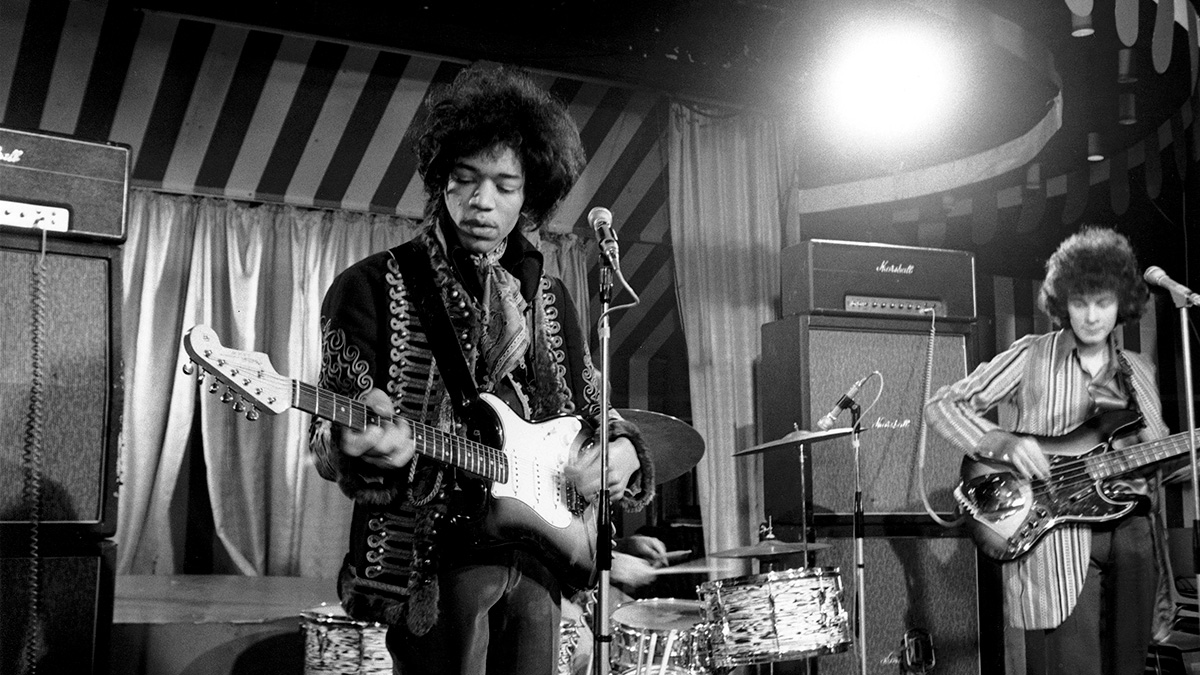
Make Do and Mend
Back to London briefly for a few UK shows and TV appearances, the band was soon off again for a romp through Europe in September ’67, with Jimi playing almost exclusively a white/rosewood Strat.
Upon his return, he played another gig at the Saville and used a white Strat that on closer inspection had received some unusual mods. Roger Mayer did the work. He says the Strat in question had been “biffed up”, another victim of Jimi’s energetic stagecraft.
“It was broken pretty much along the glue joints,” Roger recalls, “so we re-glued it and used long screws to hold it all together. I resurfaced the neck, with a lot of attention to the neck-body joint, to be sure we maintained the sustain.”
The controls had been ripped apart, and with Fender spares unavailable back then, Roger put on three black knobs and replaced the three-way switch with three mini-toggles.
“The three toggles turned each pickup off or on, which gives you seven combinations,” he explains, “which was useful if you wanted to have bridge and neck, bridge and middle, all three – whatever. And those type of switches were pretty stage-proof. Jimi-proof!
“I mean, sometimes when he raked the amplifier with the neck of his guitar the violence was such that the wire-wound strings would be cut right through on each fret. Anyway, repairs done, we had the guitar repainted at my dad’s firm, which did product finishing for the electronics industry. It was painted Old English White, a British Motor Corporation colour.”
By the end of November, Jimi had three white/rosewood Strats on hand for at least one gig (in Blackpool), and he was by now in the habit of throwing one toward the back of the stage and past the amps as a performance flourish. Tough though Strats may be, this is not the kind of treatment they were designed for, and yet more lash-ups and running repairs were necessarily made.
Good Morning Woodstock
From the start of February ’68, the Experience shifted their attention from the UK and Europe and concentrated on playing across the pond in America. At first, Jimi continued to play white/rosewood Strats, although roadie Neville Chester bought what he called in his diary “another secondhand Strat” at Manny’s music store in New York City early in March.
A few days later Jimi was playing this sunburst/rosewood Strat alongside a white one. A blue Strat turned up at gigs around this time, too, apparently in Fender’s Lake Placid Blue finish, but its headstock was split apart thanks to one of those flights to the back of the stage, and it limped on until retired in September.
From October, still gigging incessantly in the States, Jimi began using two new Strats, both with maple fingerboards, one in Olympic White (Mitch Mitchell said it was another Manny’s purchase) and one in Black.
They appear to have lasted Jimi until his death, just under two years later. For a European tour in January ’69, he used a black/maple Strat exclusively, and at the Albert Hall in February he smashed a sacrificial sunburst/rosewood model.

From that time on, almost without exception, he would play a black and a white maple-’board Strat interchangeably. In May, a white one suffered some damage at the neck-headstock join, possibly a break, leading to a gig in June where he played a white Strat with a Telecaster neck temporarily attached.
The most celebrated of Hendrix performances came early one morning at the Woodstock festival in August ’69, with a new band he’d assembled after the Experience split, and he played a white/maple Strat.
Following a brief time fronting the Band Of Gypsys with Buddy Miles on drums and Billy Cox on bass, he put together an Experience with Mitch on drums and Billy on bass. For his final gig – in September 1970 at a festival on Fehmarn island in Germany, and just 12 days before his untimely death – he played both a black and a white maple ’board Strat.
Where Are They Now?
Today, there are a few well-documented Stratocasters known to be instruments that Jimi played. There have also been a number of guitars offered for sale through the years that were less convincing, some laughably so.
Talk to any professional involved in Hendrix-related auctions or museums or collections and the subject inevitably comes up. They will tell you that many of the “Hendrix Strats” put up for sale have questionable provenance.
They will add – with raised eyebrows – that some of those have still managed to sell, and for big money. And they will conclude that some purported ex-Jimi Strats might actually be right, but that they lack enough supporting material to prove their authenticity.
Let’s take a brief look at two of the best surviving Hendrix Stratocasters, both owned by MoPOP, the Museum of Pop Culture in Seattle, Washington. The museum was established by Microsoft co-founder Paul Allen, who bought the white ’68 Strat that Jimi played at Woodstock and other later-period gigs.
Paul acquired it for $770,000 from Gabriele Ansaloni, aka Red Ronnie, an Italian radio and TV host, who had bid successfully for the instrument in London back in 1990 at a Sotheby’s auction, where it was sold for its owner, Mitch Mitchell.
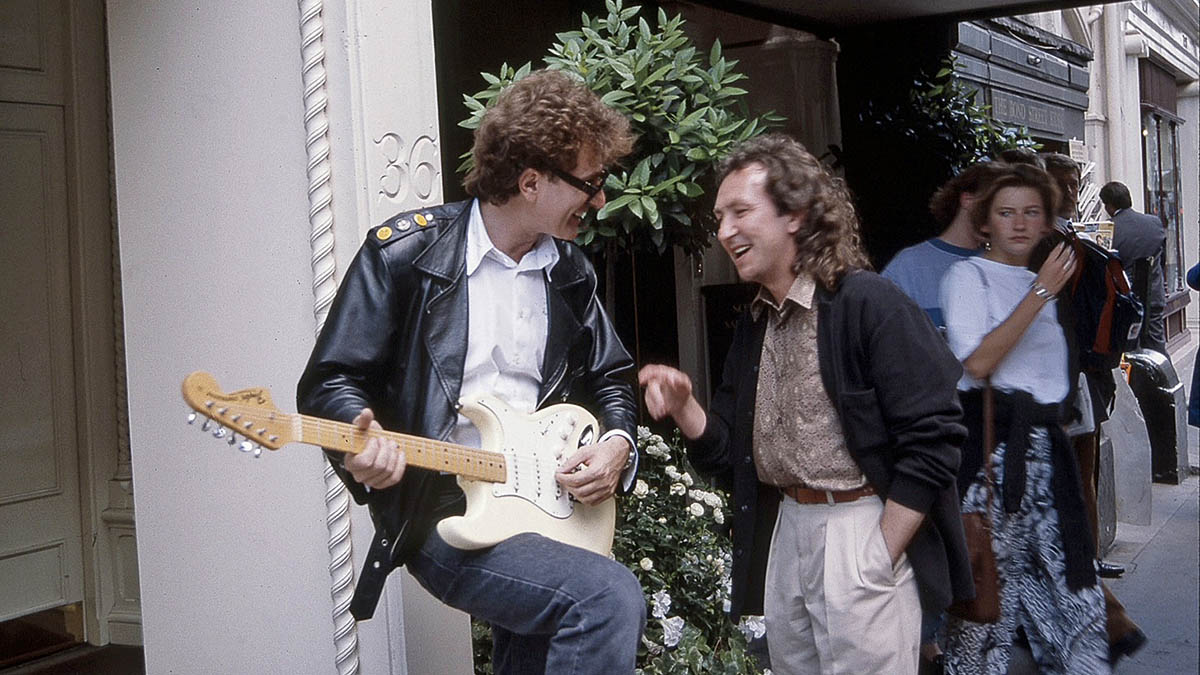
Gabriele paid £198,000, at the time a record price for a guitar, and he says he bought the Woodstock Strat because he’s a Hendrix fan. “In a way,” he recalls, “Jimi contacted me – that’s a long, long story – and I had to buy that guitar. I had it for two years, and one day Mick Hucknall of Simply Red was staying at my house.
“I showed him the guitar, and he said no-one is to play that guitar – it’s like Van Gogh’s brushes, no-one has to touch them. I had the idea to do a benefit show and ask Eric Clapton to play it, but after Mick said those things to me, I didn’t do anything with that guitar.”
He adds: “I knew I wasn’t the owner of that guitar. In fact, Mitch Mitchell said I am not the owner – it’s in my hands, but I am not the owner. So, one night in 1992 I asked Jimi Hendrix: ‘I have no money, the bank wants money back, what do I have to do with that guitar?’ And the day after, I had a phone call from Paul Allen’s secretary telling me that he wanted to do a museum, asking me if I wanted to sell that guitar. And I said yes.”
Peter Blecha was a full-time curator with Paul Allen from 1993 to 2001, helping to steer what began as a private collection to become a museum, which opened in 2000 as the Experience Music Project. He remembers, soon after the white Strat’s acquisition, that rumours circulated questioning its authenticity. So he set about proving its use at Woodstock.
“I arranged for digital close-ups of the neck, so we could look at the grain on the fretboard or on the back of the neck or on the headstock,” Peter says. “We got the highest quality Woodstock video footage we could and took stills of certain frames. Then we got the guitar out, lined them up, and they matched. We never had any doubt the guitar was real, but at that point we proved it, based on the wood-grain fingerprints.”
Jacob McMurray, who is the current director of curatorial, collections & exhibits at MoPOP, says the Woodstock Strat sits at the very top of the Hendrix hierarchy among the museum’s 6,000 Jimi-related artefacts. “And one of my favourites in the whole collection is the fragment of the guitar he smashed at the Saville Theatre,” Jacob reports. The museum acquired these two broken body halves at another Sotheby’s auction in London, in 1991, paying £29,700.
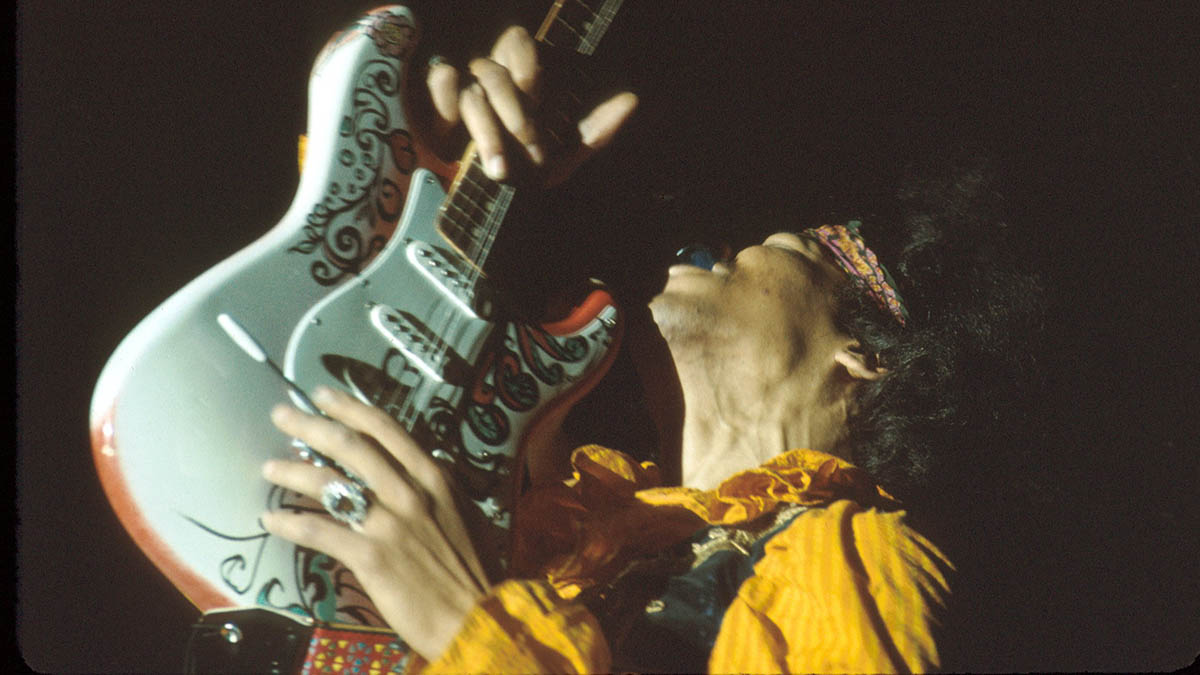
“I love the fact that when Jimi landed in London in late September ’66 he was totally unknown, but nine months later he’s on top of the British pop charts, and he plays this last show before he goes to appear at Monterey,” Jacob says. “It’s a few days after the release of Sgt Pepper’s, and he comes out playing a cover of the title track almost as an homage to the scene that’s allowed him prominence.
“And the guitar he smashes is so Jimi, with those psychedelic swirls and the Love or Confusion-esque poem on the back. I did a Nirvana exhibit here at the museum, and while Kurt Cobain smashed a lot of guitars, he did so for very different reasons. For Kurt, it was a kind of punk-rock nihilism. Jimi, though, wrote on the back of that Strat, ‘My darling guitar, rest in peace, amen.’ For him,” Jacob concludes, “it was a loving sacrifice to the musical gods.”
An imposing monument stands in honour of Jimi at his gravesite at Greenwood Memorial Park in Renton, Washington. In the centre, on a plinth under a granite dome, stands a sculpted electric guitar. It is unmistakably a Fender Stratocaster. That mesmerising combination – Jimi Hendrix and his Fender Stratocaster – still haunts guitarists to this day. “We use the same thing anyone else would,” he told Guitar Player in 1968, “but we use it with imagination and common sense.”
- Tony Bacon would like to thank: Gabriele Ansaloni (Red Ronnie), Sid Bishop, Pete Blecha, Craig Bradley, Dave Brewis, Chas McCue, Jörg Düsedau, Mike Eldred, Craig Inciardi, Tony Magee, Perry Margouleff, Nev Marten, Stephen Maycock, Roger Mayer, and Jacob McMurray.
“My brother's trying to knock Norm down in price. He's worth $800 million. He goes, ‘I'll give you a bottle of whiskey on top’”: Frank Stallone on the prized vintage Epiphone that Sylvester bought him – and the guitar's mysterious origins
“More people play stop-tails than guitars with locking tremolos. We dig both”: EVH delivers on its hardtail promise and launches the Wolfgang Standard T.O.M. – which vows to take Eddie's legacy to new heights




